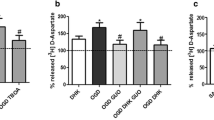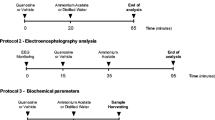Abstract
We have proposed that acute ammonia toxicity is mediated by activation of the N-methyl-D-aspartate type of glutamate receptors. MK-801, a selective antagonist of these receptors, prevents death of animals induced by acute ammonia intoxication as well as ammonia-induced depletion of ATP. It seems therefore that, following activation of the N-methyl-D-aspartate receptors, the subsequent events in ammonia toxicity should be similar to those involved in glutamate neurotoxicity. As it has been shown that inhibitors of nitric oxide synthetase such as nitroargnine prevent glutamate toxicity, we have tested whether nitroarginine prevents ammonia toxicity and ammonia-induced alterations in brain energy and ammonia metabolites. It is shown that nitroarginine prevents partially (≈50%), but significantly death of mice induced by acute ammonia intoxication. Nitroarginine also prevents partially ammonia-induced depletion of brain ATP. It also prevents completely the rise in glucose and pyruvate and partially that in lactate. Injection of nitroarginine alone, in the absence of ammonia, induces a remarkable accumulation of glutamine and a decrease in glutamate. The results reported indicate that nitroarginine attenuates acute ammonia toxicity and ammonia-induced alterations in brain energy metabolites. The effects of MK-801 and of nitroarginine are different, suggesting that ammonia can induce nitric oxide synthetase by mechanisms other than activation of N-methyl-D-aspartate receptors.
Similar content being viewed by others
References
Bessman, S. P. and Bessman, A. N. 1955. The cerebral and peripheral uptake of ammonia in liver disease with an hypothesis for the mechanism of hepatic coma. J. Clin. Invest. 34:622–628
Fischer, J. E., and Baldessarini, R. J. 1971. False neurotransmitters and hepatic failure. Lancet II, 75–79
James, J. H., Ziparo, V., Jeppson, B., and Fischer, J. E. 1979. Hyperammonemia, plasma amino acid imbalance and blood-brain amino acid transport: a unified theory of portal systemic encephalopathy. Lancet II, 772–775
Zieve, L., Doizaki, W. M., and Zieve, F. J. 1974. Synergism between mercaptans and ammonia in the production of coma: a possbile role for mercaptans in the pathogenesis of hepatic coma. J. Lab. Clin. Invest. 83:16–28
Schafer, D. F. and Jones, E. A. 1982 Hepatic encephalopathy and the Γ-aminobutyric acid neurotransmitter system. Lancet II, 18–19
Marcaida, G., Felipo, V., Hermenegildo, C., Miñana, M. D., and Grisolía, S. 1992. Actute ammonia toxicity is mediated by the NMDA type of glutamate receptors. FEBS Lett. 296:67–68
Hawkins, R. A., Miller, A. L., Nielsen, R. C., and Veech, R. L. 1973. The acute action of ammonia on rat brain metabolism in vivo. Biochem. J. 134:1001–1008
Hindfelt, B., and Siesjo, B. K. 1971. Cerebral effects of acute ammonia intoxication. Scand. J. Clin. Lab. Invest. 28:365–374
Hindfelt, B., Plum, F., and Duffy, T. E. 1977. Effect of acute ammonia intoxication on cerebral metabolism in rats with portacaval shunts. J. Clin. Invest. 59:386–396
Kosenko, E., Kaminsky, Y. G., Felipo, V., Miñana, M. D., and Grisolía, S. 1993. Chronic hyperammonemia prevents changes in brain energy and ammonia metabolites induced by acute ammonia intoxication. Biochim. Biophys. Acta 1180:321–326
Felipo, V., Grau, E., Miñana, M. D., and Grisolía, S. 1993. Ammonium injection induces an N-methyl-D-aspartate receptor mediated proteolysis of the microtubule-associated protein MAP-2. J. Neurochem. 60:1626–1630
Felipo, V., Grau, E., Miñana, M. D., and Grisolía, S. 1994. Activation of NMDA receptor mediates the toxicity of ammonia and the effects of ammonia on the microtubule-associated protein MAP-2. Adv. Exp. med. Biol. 341:83–94
Kosenko, E., Kaminsky, Y., Grau, E., Miñana, M. D., Marcaida, G., Grisolía, S., and Felipo, V. 1994. Brain ATP depletion induced by acute ammonia intoxication in rats is mediated by activation of the NMDA receptor and of Na+/K+-ATPase. J. Neurochem. 63:2172–2178
Faraci, F., and Breese, K. R. 1993. Nitric oxide mediates vasodilatation in response to activation of N-methyl-D-aspartate receptors in brain. Circ. Res. 72:476–480
Garthwaite, J., Charles, S. L., and Chess-Williams, R. 1991. Endothelium-derived relaxing factor release on activation of NMDA receptors suggests role as intercellular messenger in the brain. Nature 336:385–388
Izumi, Y., Clifford, D. B., and Zorumski, C. F. 1992. Inhibition of long term potentiation by NMDA-mediated nitric oxide release. Science 257:1273–1276
Manev, H., Favaron, M., Guidotti, A., and Costa, E. 1989. Delayed increase of Ca2+ influx elicited by glutamate: role in neuronal death. Mol Pharmacol. 36:106–112
Meldrum, B., and Garthwaite, J. 1990. Excitatory amino acid neurotoxicity and neurodegenerative disease. Trends Pharmacol. Sci. 11:379–387
Choi, D. W. 1992. Excitotoxic cell death. J. Neurobiol. 23:1261–1276
Dawson, V. L., Dawson, T. M., London, E. D., Bredt, D. S., and Snyder, S. H. 1991. Nitric oxide mediates glutamate neurotoxicity in primary cortical cultures. Proc. Natl. Acad. Sci. USA 88:6368–6371
Izumi, Y., Benz, A. M., Clifford, D. B., and Zorumski, C. F. 1993. Nitric oxide inhibitors attenuate N-methyl-D-aspartate excitotoxicity in rat hippocampal slices. Neurosci. lett. 135:227–230
Vigé, X., Carreau, A., Scatton, B., and Nowicki, J. P. 1993. Antagonism by NG-nitro-L-arginine of L-glutamate-induced neurotoxicity in cultured neonatal rat cortical neurons. Prolonged application enhances neuroprotective efficacy. Neuroscience 55: 893–901
Kunst, A., Draeger, B., and Ziegenhorn, J. 1984. Glucose, In: Methods of Enzymatic Analysis (Bergmeyer, H. U., ed). 3rd ed, Vol. 6, 163–172, Verlag Chemie, Weinheim
Transtschold, I., Lamprecht, W., and Schweitzer, G. 1985. Adenosine-5′-triphosphate: UV method with hexokinase and glucose-6-phosphate dehydrogenase. pages 346–357,in Bergmeyer, H. U., (ed.) Methods of Enzymatic Analysis 3rd ed, Vol 7, Verlag Chemie, Weinheim.
Jaworet, D. and Welsch, J. 1985. Adenosine-5′-diphosphate and adenosine-5′-monophosphate. pages 365–370,in Bergmeyer, H. U., (ed.) Methods of Enzymatic Analysis 3rd ed, Vol 7, Verlag Chemie, Weinheim.
Noll, F. 1984. Lactate, pages 582–589,in Bergmeyer, H. U., (ed.) Methods of Enzymatic Analysis 3rd ed, Vol 6, Verlag Chemie, Weinheim.
Lamprecht, W. and Heinz, P. 1984. Pyruvate. pages 570–577,in Bergmeyer, H. U., (ed.) Methods of Enzymatic Analysis 3rd ed, Vol 6, Verlag Chemie, Weinheim
Bernt, E. and Bergmeyer, H. U. 1974. Glutamate. Pages 1704–1708,in Bergmeyer, H. U., (ed.) Methods of Enzymatic Analysis 2nd ed, Vol 4, Verlag Chemie, Weinheim
Lund, P. 1974. Glutamine: determination with glutaminase, and glutamate dehydrogenase. Pages 1719–1722,in Bergmeyer, H. U., (ed.) Methods of Enzymatic Analysis 2nd ed, Vol 4, Verlag Chemie, Weinheim
Taussky, H. H. and Shorr, E. 1953. A microcolorimetric method for the determination of inorganic phosphorous. J. Biol. Chem. 202:675–685
Bergmeyer, H. U. and Beutler, H. O. 1985. Ammonia. Pages 454–461,in Bergmeyer, H. U., (ed.) Methods of Enzymatic Analysis 3rd ed, Vol 8, Verlag Chemie, Weinheim
Atkinson, D. E. and Walton, G. M. 1967. Adenosine triphosphate conservation in metabolic regulation: rat liver citrate cleavage enzyme. J. Biol. Chem. 242:3239–3241
Meister, A. 1985. Glutamine synthetase from mammalian tissues. Methods in Enzymol. 113:185–199
Hahn, M., Massen, O., Nenchi, M. and Pavlov, I. 1893. Die Eck'sche fistel zwischen der unteren hohlvene und der pfortader und ihre folgen für den organismus. Arch. Exp. Path. Pharmak. 32:161–173
Choi, D. W. 1987. Ionic dependence of glutamate neurotoxicity. J. Neurosci. 7:369–379
Novelli, A., Reilly, J. A., Lysko, P. G., and Henneberry, R. C. 1988. Glutamate becomes neurotoxic via the N-methyl-D-aspartate receptor when intracellular energy levels are reduced. Brain Res. 451:205–212
Thomas, G. and Ramwell, P. W. 1988. Vasodilatory properties of mono-L-arginine containing compounds. Biochem. Biophys. Res. Commun. 154:332–338
Wettstein, M., Gerok, W., and Häussinger, D. 1994. Endotoxin-induced nitric oxide synthesis in the perfused rat liver: effects ofL-arginine and ammonium chloride. Hepatology 19:641–647
Author information
Authors and Affiliations
Rights and permissions
About this article
Cite this article
Kosenko, E., Kaminsky, Y., Grau, E. et al. Nitroarginine, an inhibitor of nitric oxide synthetase, attenuates ammonia toxicity and ammonia-induced alterations in brain metabolism. Neurochem Res 20, 451–456 (1995). https://doi.org/10.1007/BF00973101
Accepted:
Issue Date:
DOI: https://doi.org/10.1007/BF00973101




